Are you looking for the best things to do in Gdansk for your upcoming trip? This guide is here to help! Keep reading to see my top picks for your Gdansk bucket list!
If youʻre booking your trip to Gdansk last minute, we have you covered. Below are some of the top tours, hotels, and more!
🇵🇱 Top Experiences and Tours in Gdansk:
- City Cruise on Historical Polish Boat (top-rated tour in Gdansk!)
- Stutthof Concentration Camp Regular Tour (day trip option)
- Pub Crawl with Free Drinks (great for groups!)
- City Tour by Electric Golf Cart
- Traditional Polish Food Private Tour (perogies for all!)
🛌 Top Hotels in Gdansk:
- IBB Hotel Gdańsk (we stayed here- best views of old town!)
- Hotel Hanza (also stayed here & has great restaurant!)
- Gotyk House (stylish interior in a house from 1451!)
🚗 Looking for the best way to get around Gdansk? Click here to check rental car rates for Poland!
We recently went to Gdansk and it quickly became my favorite city in Poland! I can’t even describe how cool the place is!
In this guide, we are discussing what to do in Gdansk for first-time visitors, as well as some of our favorite spots to eat, drink, and enjoy a refueling coffee.
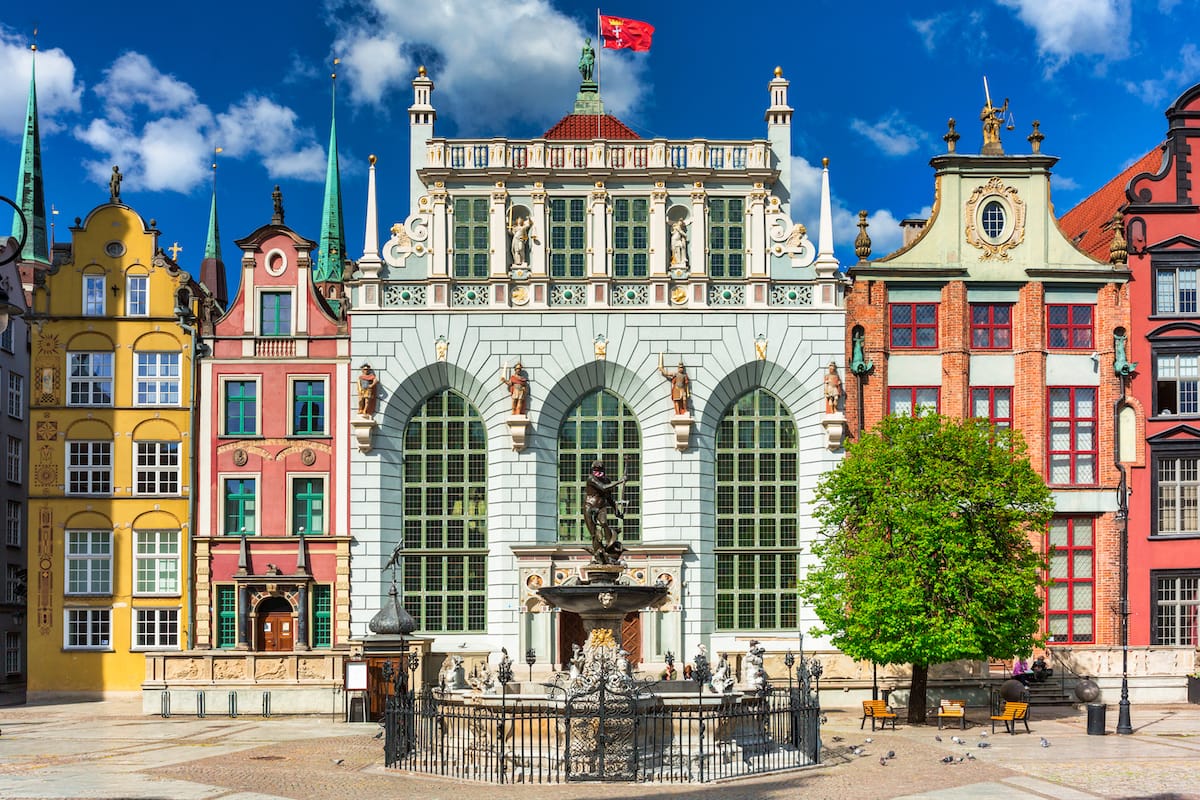
Did we miss any of the top Gdansk attractions or things to do? Let us know in the comments!
In this post...
Best Things to Do in Gdansk
1. Climb the Tower of St. Mary’s Church (for Great Views!)
The most renowned architectural and historical site and the most visible structure in Gdansk is St. Mary’s Church, or the Basilica of the Assumption of the Blessed Virgin Mary, which captivates with its beauty and size.
It is the largest brick church in the world and a bright example of Gothic splendor, with intricate stained glass windows, ornate altars, and an impressive 15th-century astronomical clock.
The most precious things to check out in the church are the Gothic altar of the Mother of God’s Coronation and the figures of the Beautiful Madonna and Pietà.
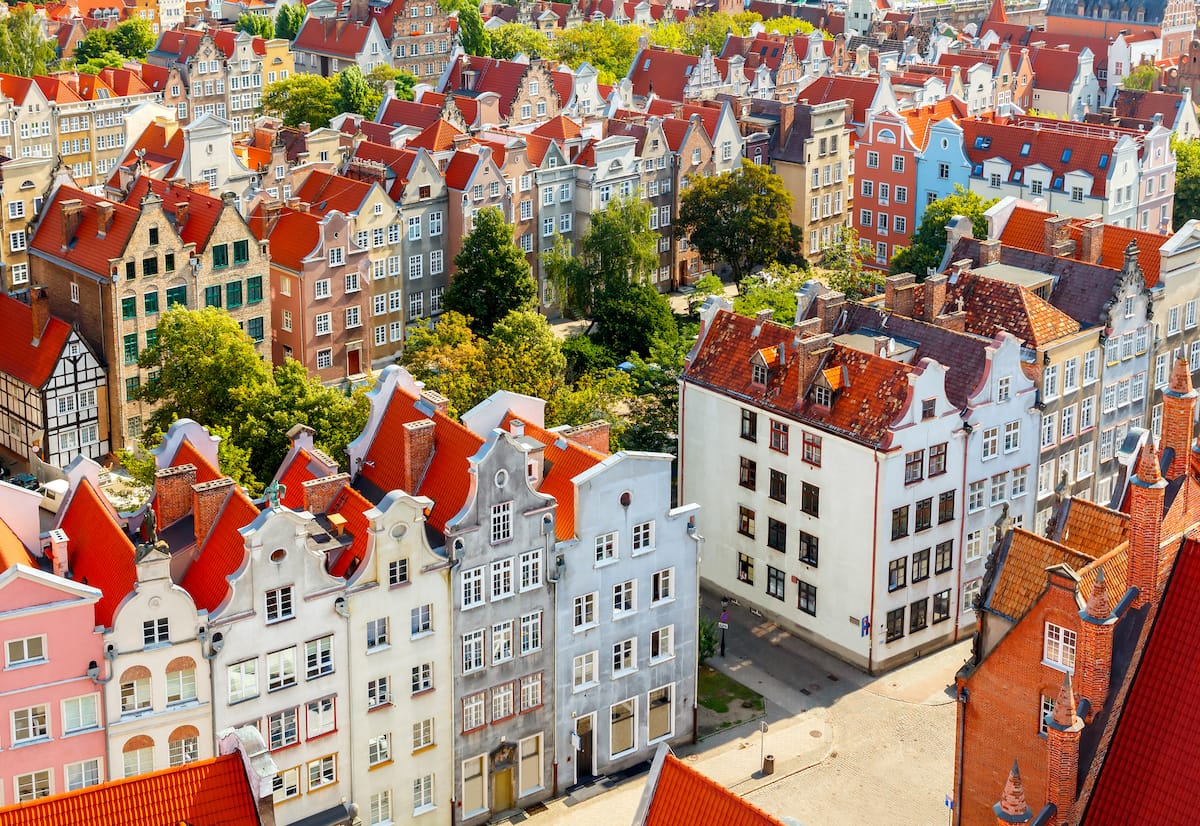
Unfortunately, the church was set on fire in 1945 and badly damaged. After the war, it was reconstructed.
While the church is definitely a must-see attraction, you are coming here for the great views from the church tower.
Steps lead to the tower through a narrow spiral staircase (not the best option for claustrophobics).
Finally, after a heart-pounding climb, you reach the observation deck, a space that will reward you with a 360-degree view of the Old Town, the Motlawa River, the Green Gate, Neptune’s Fountain, and the majestic Gothic Town Hall.
2. Stroll through the Colorful Old Town
The heart of Gdansk is the Old Town, a charming neighborhood with stunning architecture and a vibrant culture.
Destroyed during the war and reconstructed in the 1960s, Gdansk Old Town now showcases a rich history dating back to the 10th century.
The Old Town is small, with a symphony of colors across the facades. The architecture showcases a blend of Gothic, Renaissance, and Baroque styles, each contributing to the town’s distinct character.
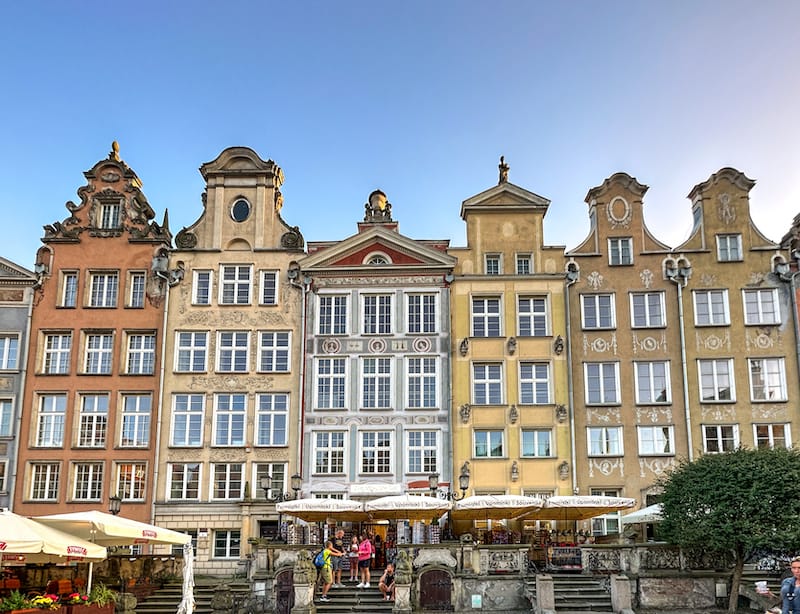
Start exploring the neighborhood by following the Royal Way, the parade route of kings that starts at Brama Wyżynna and takes you through Złota Brama, ending at Zielona Brama.
On your way, you will see the replica mercury thermometer, a tribute to Daniel Fahrenheit.
You will then slowly approach the banks of the Motlawa River to discover one of the symbols of Gdansk, Żuraw (the Crane), used to transfer cargo.
When you are done exploring all the stunning buildings and museums of the Gdansk Old Town, visit Piwnica Rajców, a multi-tap bar, to taste a true Polish beer.
3. Visit the National Museum of Gdansk
The history and culture of Gdansk are best portrayed in the National Museum of Gdansk, one of the major museums in Poland.
Occupying a 16th-century late-Gothic Franciscan monastery, the museum is a must-visit place for the building’s architecture and the museum’s collection.
Most of the museum was destroyed during WWII. Fortunately, the exhibitions had been evacuated before the attack, and even though many works were lost, most part is now safely showcased in the museum.
The building itself is a work of art, designed to seamlessly blend with the surrounding cityscape.
The National Museum boasts an extensive permanent collection, including the renowned painting by Hans Memling, “The Last Judgment.”
The rest of the exhibits are divided into five sections: Paintings and Drawing, Graphics and Textiles, Ceramics and Sculpture, Theater Department, and the Gallery of Polish Modern Art.
Address: Toruńska 1, 80-822 Gdańsk
4. People-Watch along Bustling Dluga Street
There are many beautiful places in Gdansk not to miss, and ul. Długa is one of them.
The long street (by the way, ul. Długa means long street) in the Gdansk Old Town twists from the Golden Gate to the Town Hall and covers the majority of the Royal Route with some of the most prominent buildings.
The cobbled street is brimming with Renaissance and Gothic-style facades on both sides, finished with intricate sculptures and ornate balconies.
One interesting thing to pay attention to is the house numbers running opposite on the street sides. Used on Gdansk streets for centuries, ul. Długa kept the traditions.
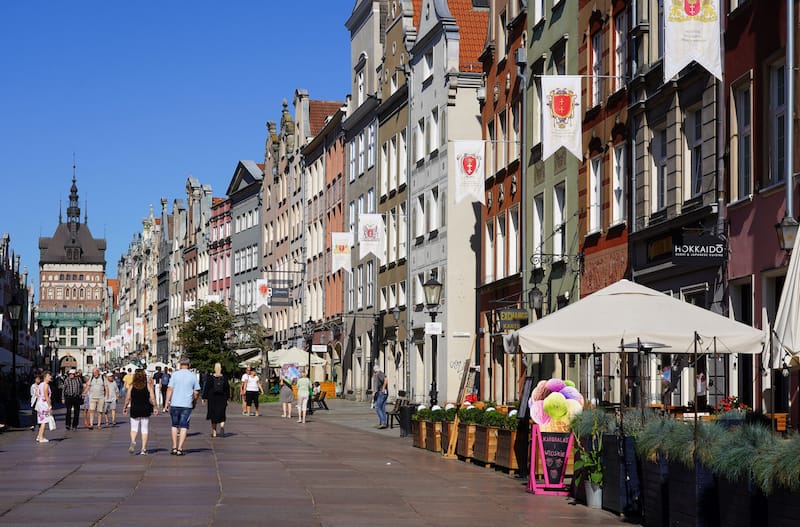
The Museum of Burgher is located in the house at number 12. The opposite is the number 71 building, the Soviet barrages.
To see what’s behind those facades, you can check out the Uphagen Mansion, open to visitors.
Explore the ul. Długa if you want to find outdoor cafes, cozy restaurants, shops, and pubs to chill in the evening.
5. Snap a Photo with the Iconic Neptune Fountain
The Neptune Fountain is a jewel of Gdansk’s Old Town and the city’s most recognizable symbol. “Fontanna Neptuna,” in Polish, is cast in bronze with a statue of the Roman god.
This impressive statue was erected in 1549, before the actual fountain, and it still stands majestically. The centerpiece of the Neptune Fountain is, of course, the magnificent sea god Neptune.
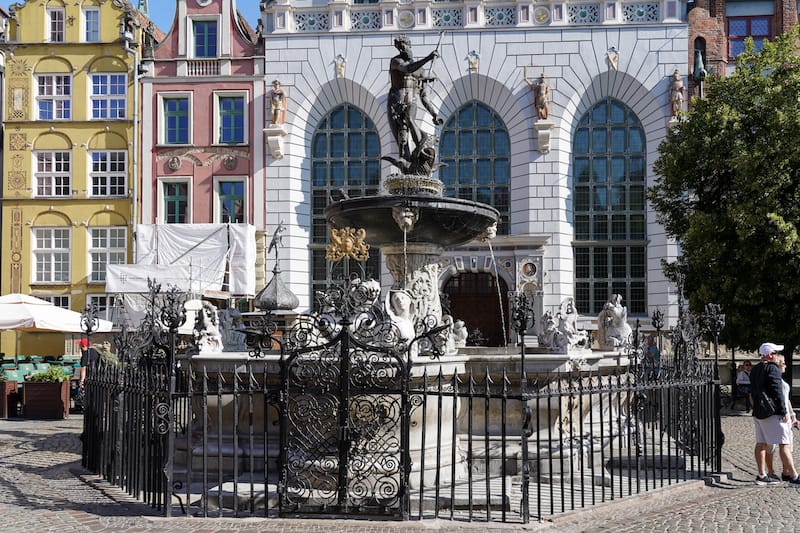
Neptune’s trident, the symbol of his dominion over the sea, rises high in the air.
The statue survived the war only because it was hidden with other treasures in Gdansk. It was returned to its place later, in 1954.
Today, the Neptune Fountain is an iconic landmark and a gathering place for locals and guests.
Surrounded by cafes, restaurants, and boutiques, Dlugi Targ offers an ideal setting for enjoying the city’s atmosphere while admiring the Neptune Fountain.
Address: Długi Targ, 80-833 Gdańsk
6. Visit Westerplatte (Where WWII Began)
Gdansk, like many other cities in Poland, carries the traces of World War II, and some places still serve as powerful reminders of the devastating events.
Westerplatte is one such place. It is a small peninsula at the entrance to the port of Gdańsk, which was attacked on September 1, 1939, the date that marked the beginning of WWII.
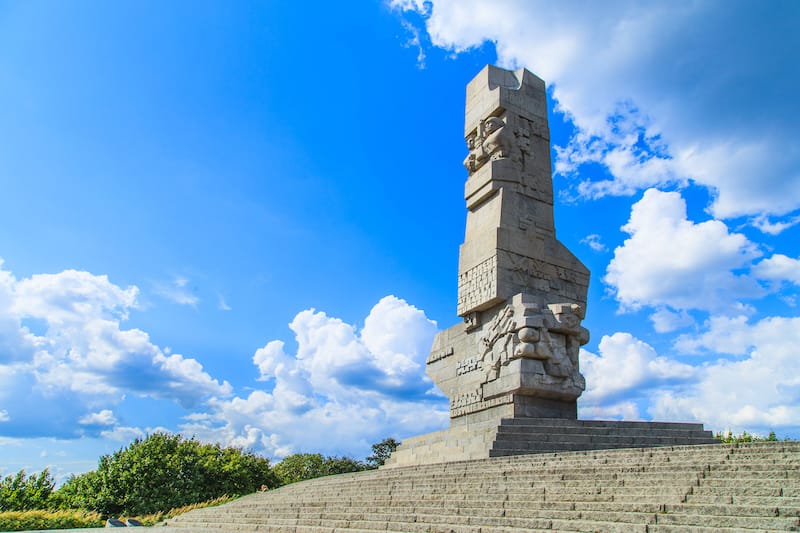
Westerplatte, once a Polish military transit depot, stands as a symbol of Polish resilience and the sacrifices made in the pursuit of freedom.
It is a historic park and memorial site with shelled bunkers, a seasonal Guardhouse Number 1 (the museum may be closed in the off-season), and a permanent outdoor exhibition.
Westerplatte often hosts military swearing-in ceremonies.
7. Refuel at a Gdansk Coffee Shop
Gdansk’s coffee scene blew my mind. As soon as I opened a map and looked for good specialty coffee shops, about 100 popped up!
While I will be writing a completely separate guide for this, here were some of my very favorites when visiting the city:
- Kawiarnia Drukarnia (on Mariacka Street – across from an amazing perfume shop called ‘Maison Store’ you need to check out!)
- Balans Kawy Speciality & Bajgiel (went there 3 times – was my favorite cafe in the city)
- ZORZA Kawiarnio – Kwiaciarnia (a coffee shop and flower shop rolled into one)
- Plenum (coffee shop in a repurposed building that also houses temporary art exhibitions)
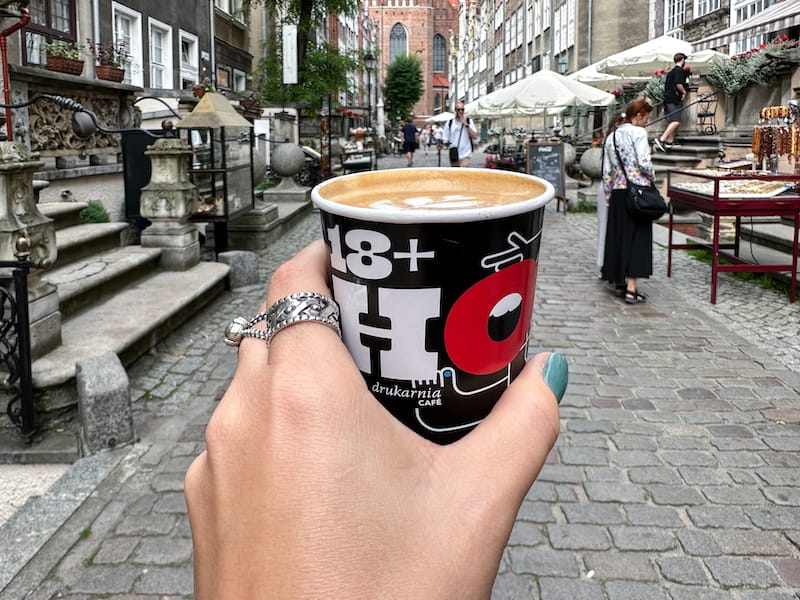
While these are only four to get you started, there are SO many more and you’ll never be that far away from a coffee shop in Gdansk!
8. Take a Relaxing Stroll through Oliwa Park
Gdansk boasts numerous historical sites worth a visit, but if you’ve missed nature, Oliwa Park is a great place to reconnect with nature.
Just a short distance from the city center, it is an 11-hectare green territory with centuries-old trees and historic monuments.
The center of the garden is a monumental Oliwska Cathedral. In fact, this historic park was founded by the Cistercians as a monastery garden to surround the Abbot’s Palace and the cathedral.
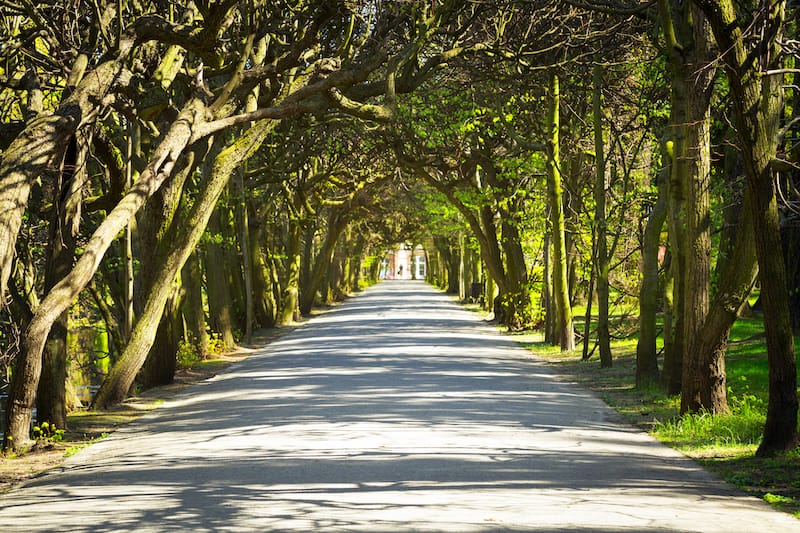
After the war, a new Botanical Garden was opened in the park, divided into themed sections, each offering a unique experience.
As you explore the park, you will probably cross the Bukowa Aleja, with trees shaping a tunnel. Follow the path to reach a picturesque pond surrounded by weeping willows and lush greenery.
People throw coins into the pond for luck and a promise to come back here one day.
9. See the Most Famous City Gate (the Golden Gate)
The iconic Golden Gate in Gdansk is a timeless symbol of history and architectural brilliance. This stunning piece of history is in the heart of the city’s Old Town, at the western exit of Długa Street.
It was erected in the 17th century and marked a period of prosperity for Gdansk. The modern gate was built on the site of the Long Street Gate, and the ruins can still be seen.
The Golden Gate’s architectural style is a harmonious blend of Flemish Mannerism and Dutch Renaissance influences.
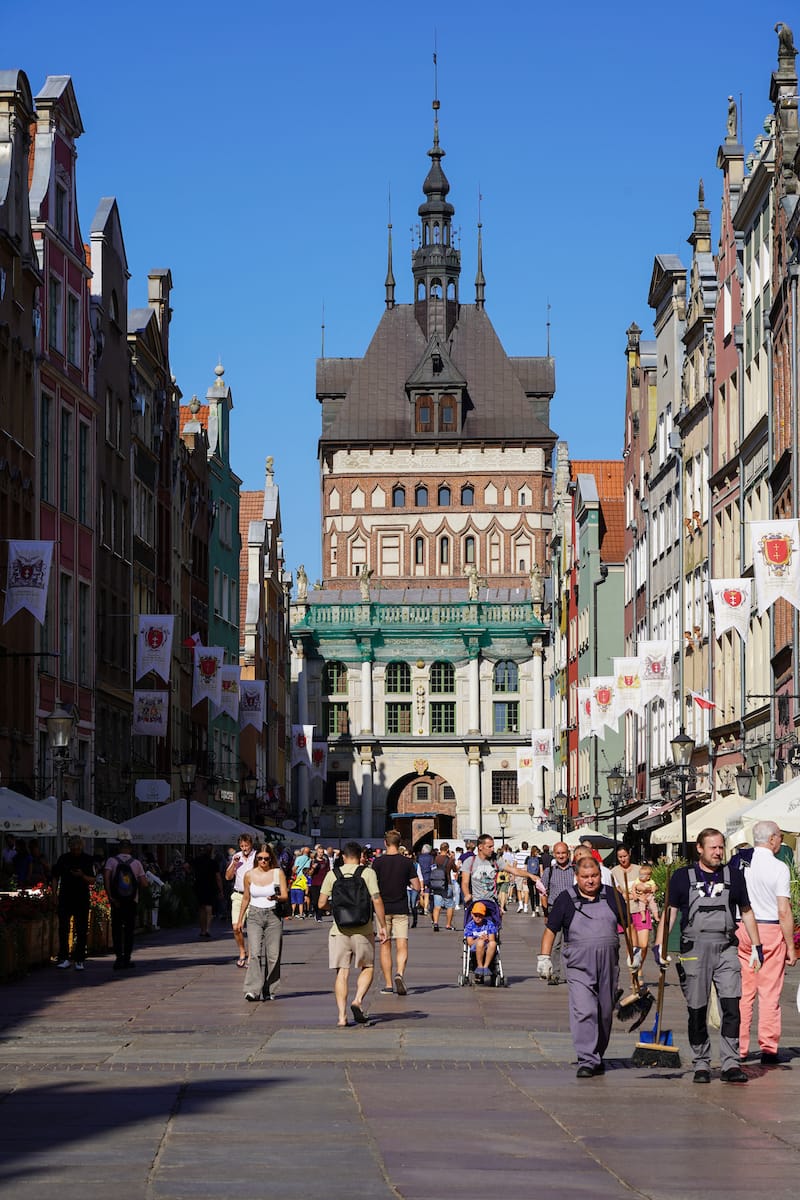
The two-story building is crowned with a balustrade and adorned with sculptures, including allegorical figures, mythological deities, and important historical personalities.
Though badly damaged during WWII, the gate was reconstructed in 1957, and today, it is one of the major symbols of Gdansk.
When passing under the arches, you will see old photos of the destroyed arch and the Old Town.
10. Dive into Gdansk History at the Main Town Hall Museum
European cities are a marvel to a history buff, especially when it comes to such cities as Gdansk. To start with Gdansk history, you should consider visiting the Main Town Hall and its museum.
The building stands at the Długa and Długi Targ streets’ crossroads.
It served as the seat of the city authorities from the 16th century on, witnessing the city’s evolution from a bustling trading port to a symbol of resilience and rebirth after World War II.
Counting over 39 thousand items, the main theme of the museum’s exhibition is the history of Gdansk from the Middle Ages to these days.
Before delving into the museum’s treasures, take a moment to admire the Main Town Hall’s exquisite architecture.
Then, spend time exploring the views from the top of the Town Hall tower, which has fantastic views of the Old Town and the nearby St. Mary’s Basilica.
Address: Długa 46, 80-831 Gdańsk
11. See the Famous Crane (Built During Gdansk’s Trading Era)
“The Crane” (Żuraw) is an iconic structure and a staple of Gdansk that you will definitely check out when exploring the riverfront.
This colossal edifice has survived as a living testament to the city’s golden age of trade and commerce.
The modern Crane stands in place of an older one which was destroyed by fire. For centuries, it was one of the gates to the city and the world’s biggest crane, with a lifting capacity of 4 tons and a height of 11 meters.
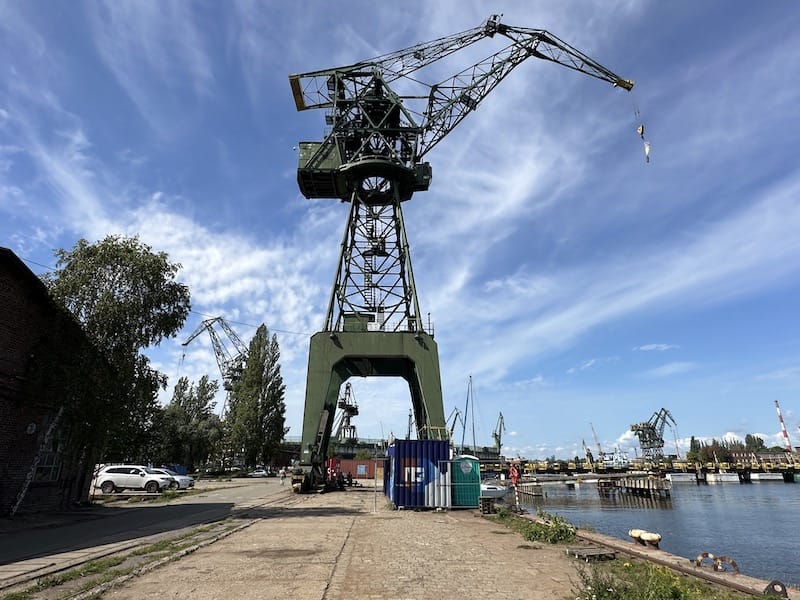
Almost destroyed during WWII, it was rebuilt and became part of the Polish Maritime Museum.
The Crane’s architectural design is a fusion of medieval and Gothic styles, with two fortified towers. The massive crane has a wooden frame with weatherboards.
Its most distinctive feature is the large wooden arm, or “jib,” which stretches out over the Motlawa River.
As you explore the Crane, don’t forget to visit the museum with unique exhibitions on port life, including models of lighthouses, counting houses, the old port, etc.
12. Explore the Culinary Scene in Gdansk
If someone were to ask me why I loved Gdansk so much, I would have to immediately point out how delicious the food was.
Everywhere I went I could find a variety of options that appealed to me – whether I was in the mood for perogies (which 95% of the time… I was) or international cuisine.

Some of the top restaurants in Gdansk that I enjoyed dining at were:
- Pierogarnia Mandu (had perogies and dumplings from other regions of the world… a chain restaurant but I ate there two times)
- Pierogarnia Stary Mlyn (in the old town – has tasty fried perogies!)
- Piwnica Rajcow (in main square – tasty duck perogies)
- Restaurant Motlava (the duck there is absolutely delicious)
While I loved enjoying Polish food (as well as its spin on European dishes like at Motlava), Gdansk also had a pretty good international food scene!
Aram and I explored a few places while there and our very favorite was Restauracje Marrakesz located at Podwale Staromiejskie 94/95.
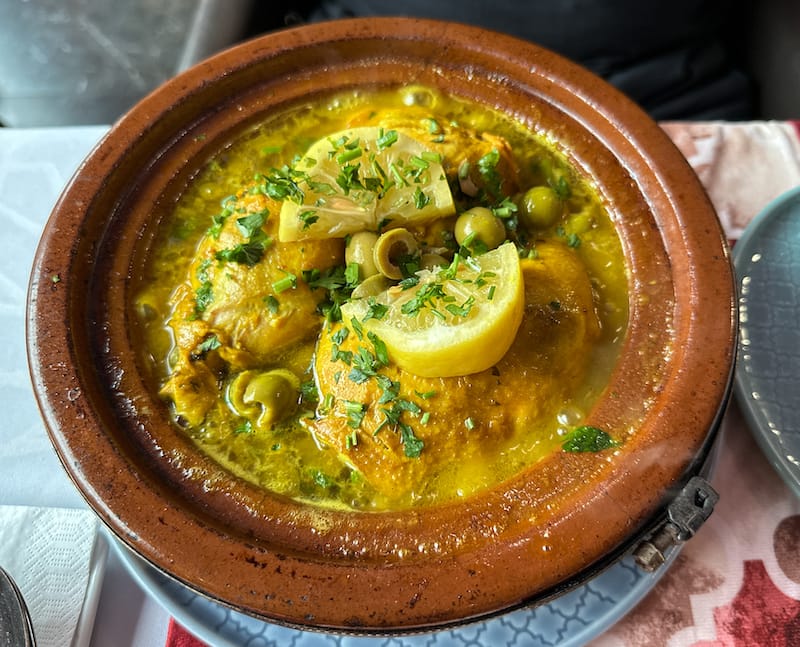
I have been to Morocco (and was in Western Sahara earlier this year) and this was one of the best dishes I have had!
The owner is a man from Agadir and he was friendly and hospitable and I can not rave about this place enough! It was stellar.
13. Learn About WWII at the Museum of the Second World War
World War II, which began with the attack of German troops at Westerplatte and took over 55 million lives, is a dark chapter in the history of mankind, that still should be embraced as a solemn reminder of the consequences of hatred and aggression and the importance of safeguarding peace and unity in our world today.
One such place that showcases history is the Museum of the Second World War in Gdansk, a remarkable institution that offers an immersive and educational experience and brings the past to life like no other.
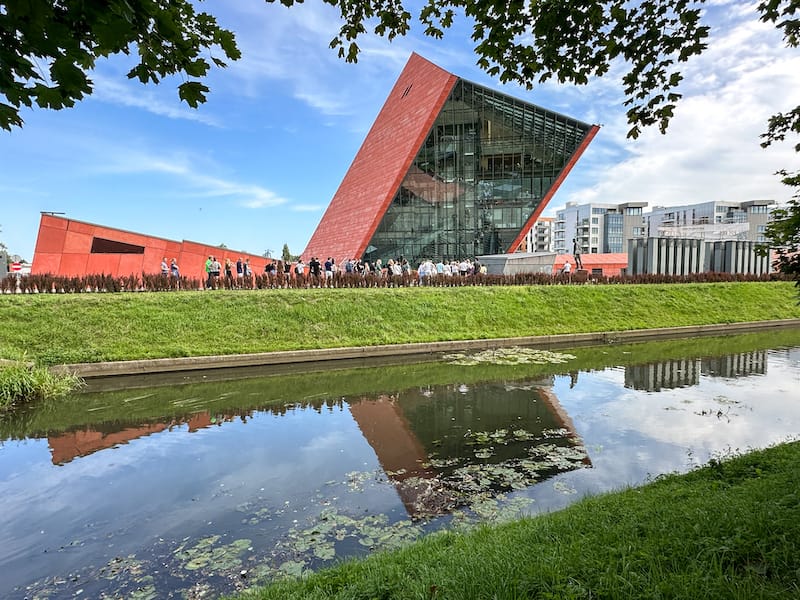
The museum is located near the Polish Post Office and not far from the Westerplatte peninsula, the place where everything began.
Occupying about 2.5 acres, the museum showcases 2000 exhibits divided into three blocks: The Road of War, The Horrors of War, and The War’s Long Shadow.
Get ready to spend at least three hours here, exploring all the exhibition rooms.
Address: plac Władysława Bartoszewskiego 1, 80-862 Gdańsk
14. Walk Along the Motlawa River
One of the most beautiful neighborhoods in Gdansk is Dlugie Pobrzeze (Long Embankment Street), which stretches along the Motlawa River.
Until the 19th century, the territory served as a port with access to the sea. Today, only a few things are left from the old port, and only the heavy lift crane has remained as part of the museum.
The modern promenade occupies the 14th-century west riverfront, with colorful buildings on one side. Most of them were badly damaged during WWII and reconstructed, keeping their previous flair.
Along the promenade, you will see restaurants and cafes serving fresh Baltic seafood and traditional Polish dishes.
Next, you will see the famous Green Gate, once the formal residence of Polish monarchs, looming at one end of the promenade.
15. Marvel at the Traditional Architecture Along Mariacka Street
Mariacka Street, often dubbed “the most beautiful street in Gdansk,” is a charming cobblestone pathway with cute outdoor cafes and galleries.
Back in the 14th century, it was the street of butchers and shoemakers, but due to the proximity of wetlands from Motława River, the street was devoid.
For centuries, the street and the city thrived, but they were destroyed during WWII. Only the number 1 house and parts of St. Mary’s Gate have survived the bombing.
Today, it is one of the city’s most beautiful streets, with brick and half-timbered buildings in Gothic, Renaissance, and Baroque styles.
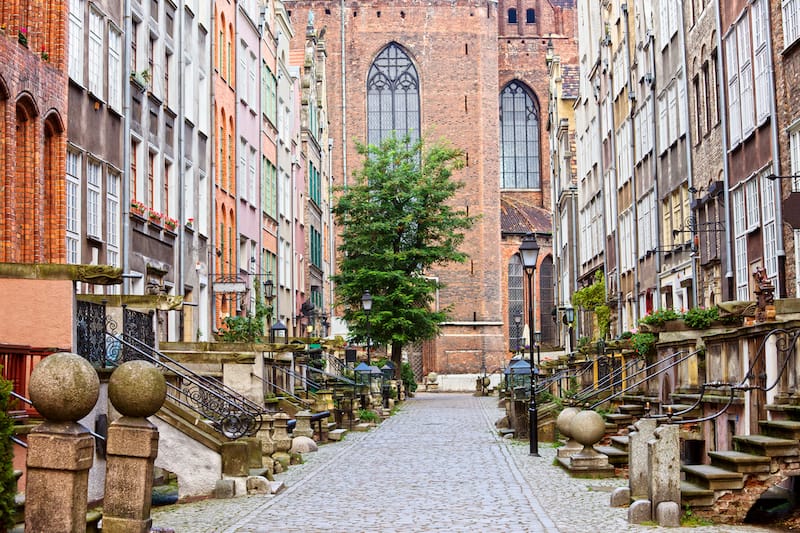
Mariacka Street is also called “Our Lady Street” by locals, referring to St. Mary’s Basilica, which crowns the street on one side. On the other side, the street ends at St. Mary’s Gate.
One of the most captivating features of Mariacka Street is its terraced porches. Those details, including the unique ornate rain gargoyles, were put together piece by piece after the war.
By the way, pay special attention to those relics, porches, and gargoyles that are the heart and soul of the Old Town.
16. See the Town From Above on a Ride on the Amber Sky Ferris Wheel
While there are many observation decks across Gdansk providing panoramic views, nothing can be compared with the breathless awe you get from the Amber Sky Ferris Wheel.
This stunning attraction promises to show you the town from a perspective like never before.
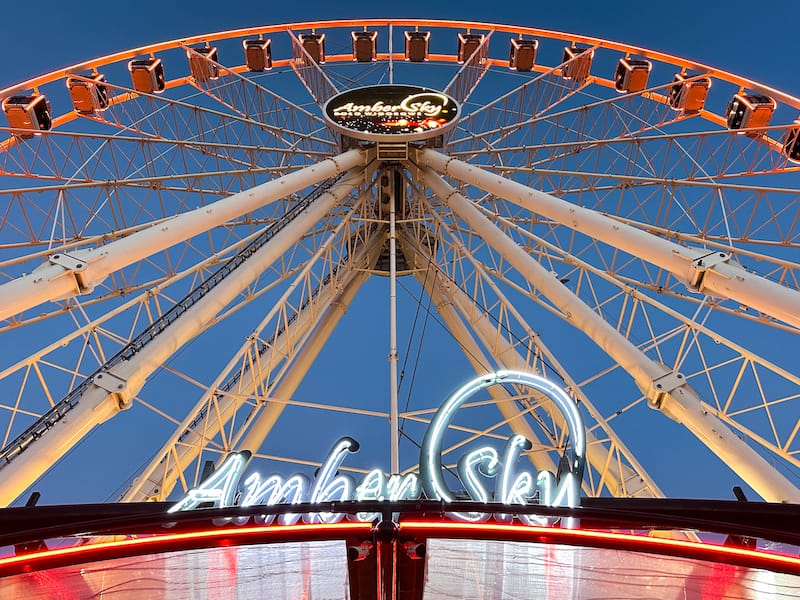
The Amber Sky Ferris Wheel, perched on the banks of the Motława River, has 36 glass cabins for 8 people and one VIP cabin with a glass floor.
The ride will take you to a height of 50 meters, opening to Gdansk day and night.
During a 15-minute ride, you will see the Crane, St. Mary’s Church, the Town Hall, the port, Energa Gdańsk Stadium, the river, and red-tiled roofs.
17. Spend a Day Chilling on the Beach
Located along the beautiful coastline of the Baltic Sea, Gdansk boasts not only a rich history and vibrant culture but also some of the best beaches in Europe.
There are several beaches you can consider visiting for an unforgettable day of relaxation… and they make for some of the most popular summer day trips from Gdansk!
Your first destination is the stunning Jelitkowo Beach. Located just a short drive from Gdansk’s city center, this beach is easily accessible by car, public transport, or even by a bike ride along the scenic coastal bike path.
Check out nearby bars and restaurants for lunch, a quick snack, and refreshing drinks.
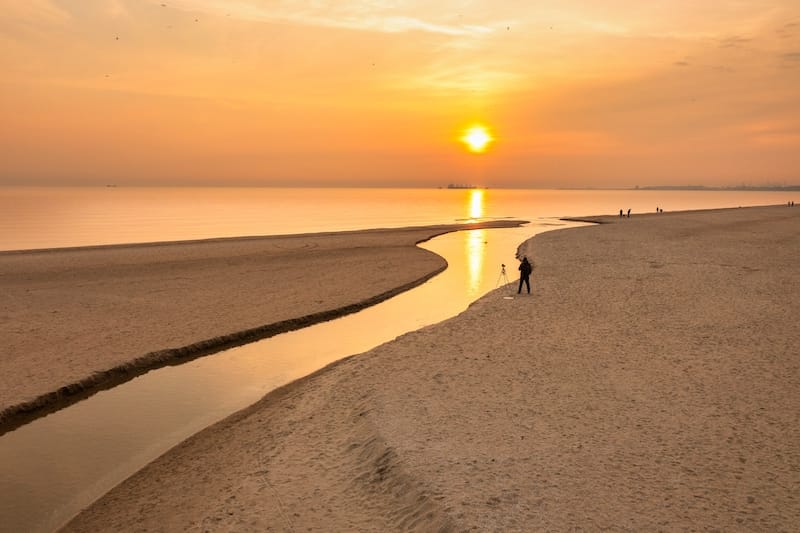
Stogi Plaza is another popular beach close to Westerplatte. It has a wider coastline and forest. The Coastal Fortifications Trail will take you on a hike where you will explore century-old bunkers and batteries.
One and a half kilometers to the right from Stogi Plaza is an unofficial nudist beach (in case you want a flawless tan).
P.S. Drinking alcohol in public places and topless sunbathing are prohibited, except in designated areas. Pay attention to the flag color before entering the sea.
The white flag means swimming is allowed, and lifeguards are watching. Red means swimming is not allowed.
18. Try Pierogies at Pierogarnia Mandu Restaurant
When it comes to Polish cuisine, few dishes are as iconic and beloved as pierogi. And there are a few places in Gdansk where you can taste exceptional dishes.
Pierogarnia Mandu is one of them, and it serves these delectable dumplings filled with a variety of ingredients.
Pierogarnia Mandu restaurant has three locations that exude charm and authenticity from the moment you step inside.
The interior of all three venues is cozy with muted colors, but everyone knows you are not coming for comfortable chairs and an interior.

The menu and food are the real value of the restaurant, with the widest selection of Polish traditional dishes and specialty dumplings.
The open-kitchen concept will show you how famous dumplings are made and served.
Pierogarnia Mandu takes pierogies seriously, offering an extensive choice of dumplings. Whether you want traditional minced meat dumplings stuffed with salmon, creamy cheese, or mushrooms, there is a choice for any taste.
And for dessert, get dumplings with berries. Their pierogi are made from scratch daily, using only the finest ingredients, and you can taste the difference in every bite.
P.S. Be prepared for lines of guests and crowds in summer and enjoy a calmer atmosphere in winter.
Address: Kaprów 19d, 80-316 Gdańsk
19. Admire the Street Art in the Zaspa Neighborhood
When exploring the charming city of Gdańsk in Poland, one neighborhood will stand out for its unique and captivating artistry.
Tucked away from the bustling city center, Zaspa is an open-air gallery with colorful murals and thought-provoking graffiti.
The very first mural appeared here in 1997, but only after the Monumental Art Festival did the neighborhood become popular.
The heart of the street art scene in Zaspa is undoubtedly the Zaspa Mural Project. It features over 60 large-scale murals on the sides of residential buildings, creating a visually stunning scene.
Artists from all over the world visited Gdansk to leave their art on the walls. To see all the murals, you will have to walk seven kilometers to one end, so be prepared for a long and captivating tour.
By the way, if you take a bird’s-eye view or observe the buildings, you will notice that they resemble a honeycomb.
20. Learn about Baltic Amber at the Museum of Amber
The Museum of Amber is one of the most atmospheric, beautiful, and valuable places in Gdansk. The city has been producing amber for centuries, and the museum is a unique tribute to Gdansk’s role in amber production.
Baltic Amber, also known as “Baltic Gold,” is a precious gemstone with a history that spans millions of years.
What sets this amber apart is its exceptional quality and the wealth of preserved inclusions within, making it a scientific and aesthetic wonder.
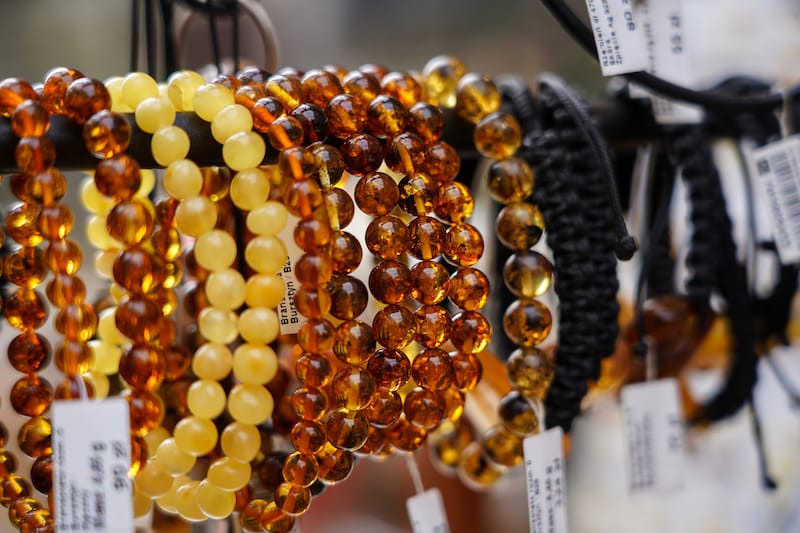
The Museum of Amber holds a collection of historic amber art from the 17th and 18th centuries. The unique exhibits include amber with fossils; you have never seen anything like this before.
No less impressive are the pieces of amber art like altars, caskets, a chess set, lockets, and more.
The museum interior is an absolute thrill. You will step into a semi-dark room with dark walls and floors, where amber looks even more mysterious.
You will learn how Baltic amber is formed, when and how Gdansk started producing amber, and see the world’s largest amber, a 68 kg block from Sumatra.
Address: Wielkie Młyny 16, 80-849 Gdańsk
21. Pop into the Oliwa Cathedral for a Free Daily Recital
The crown jewel of Oliwa Park, the Oliwa Cathedral immediately captures attention with its imposing towers and the unique sounds of the organ.
This magnificent baroque cathedral is not just a masterpiece of architecture but is also home to one of Europe’s most extraordinary pipe organs.
The 14th-century cathedral was a thriving church with monks and the most extraordinary organ in Europe when the Cistercian monks owned it.
The central piece of the cathedral is the majestic organ. This unique instrument has moving cherubs, 7896 pipes, and 110 registers that create the most incredible sounds.
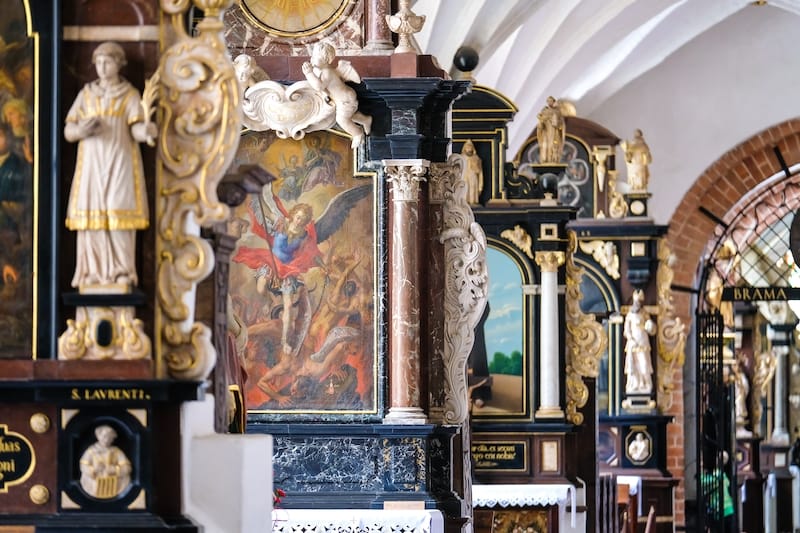
It is decorated with moving suns, moons, stars, carved flowers, and a Madonna with Child on the stained glass in the center.
In summer, the organ performs a 20-minute concert every hour, and spending those 20 minutes in the church is a pure delight.
The cathedral is equally impressive, with 23 altars in Baroque, Renaissance, and Rococo styles. It is Poland’s tallest church, measuring 107 meters, and is visible from different parts of Gdansk.
Address: Biskupa Edmunda Nowickiego 5, 80-300 Gdańsk
22. Tour the Grand Abbot’s Palace
While exploring Oliwa Park, you will discover the Grand Abbot’s Palace (Pałac Opatów), a 15th-century historical site that played a significant role in Gdansk history.
Originally constructed as a residence for the Grand Abbot of the Cistercian Order, the palace has undergone transformations over the centuries, gaining a very special allure with each layer of history.
The palace is an example of Gothic architecture with elements of Renaissance and Baroque styles. It consists of two parts, the Old and New Palaces in Gothic and Rococo styles.
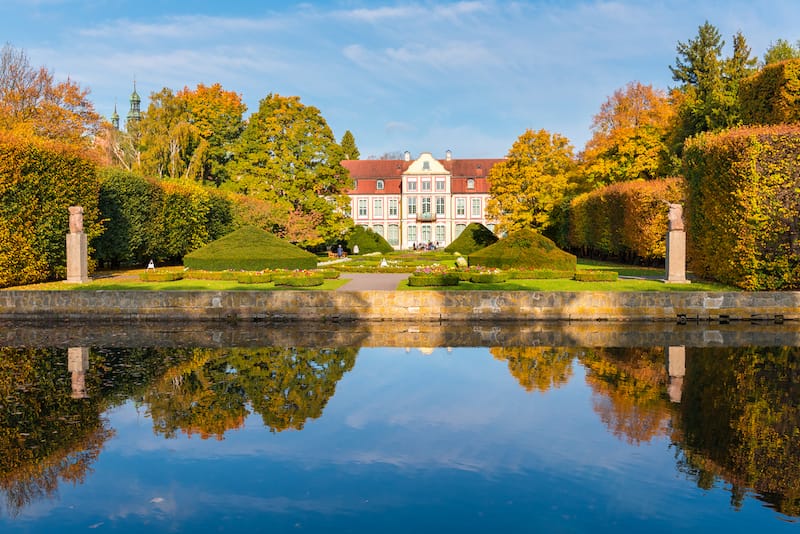
Just like most sites, the Grand Abbot was destroyed during the war and rebuilt in the 1960s, and today it hosts the Gdansk National Museum’s Modern Art collection.
As you explore the palace grounds, don’t miss the beautiful gardens and courtyards. They are also ideal for a stroll while admiring the palace’s impressive exterior.
Address: Cystersów 18, 80-330 Gdańsk
23. Eat Like a Local at the Neptune Bar (a Milk Bar)
There are many cozy restaurants and cafes in Gdansk to check out, but there is one you should visit first. When exploring the Old Town, check out Bar Mleczny Neptun, a milk bar serving traditional Polish foods.
The place serves the most popular and beloved Polish dishes in a cafeteria-style setting. Nothing more is needed to enjoy the food and atmosphere! And it is one of the best budget things to do in Gdansk!
Don’t be misled by the name, because you will not be served ‘milk’ per se. Historically, these ‘bars’ served cheap food that was dairy-based. Today, many of them have modernized, but some still stay a bit the same.
In Bar Neptun, your dinner will probably consist of a potato pancake with marinated pork, goulash sauce, broth, compote, and local ale.
Address: Długa 33/34, 80-827 Gdańsk
24. Learn More About Poland’s History at the European Solidarity Centre
The European Solidarity Centre (ESC) in the heart of Gdańsk’s historic shipyard district is a museum and cultural venue showcasing Poland’s history, particularly focusing on the role it played in the fall of communism in Eastern Europe.
The 5-story building catches attention with its unique architecture. Its exterior is a striking combination of steel and glass, symbolizing the strength and transparency of the Solidarity movement.
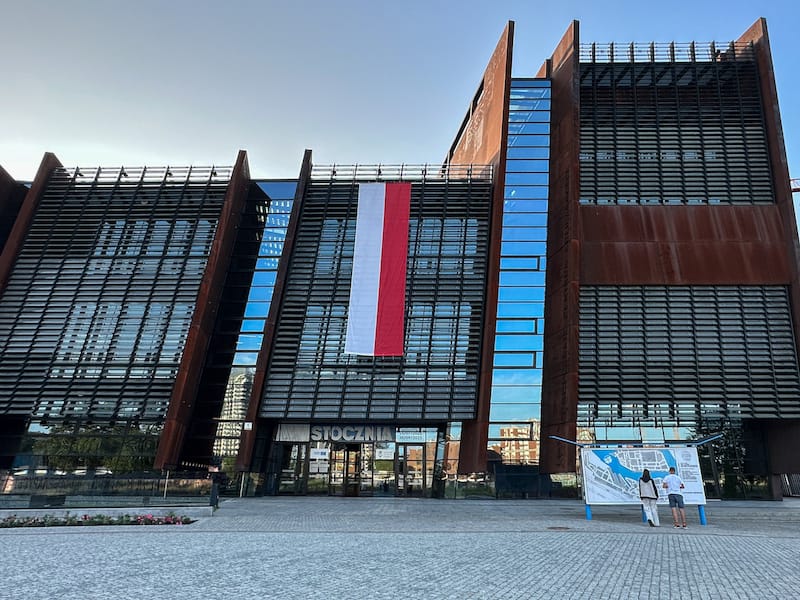
The walls, covered in rust-colored sheets, seem to be cracking and tilting. Inside, you will find a library, reading rooms, archives, conference rooms, and a beautiful viewing terrace on the roof.
The major attraction of the center is the permanent exhibition, which occupies two floors and seven halls. The exhibition tells the story of the center through traditional displays and 3D projections.
Address: pI. Solidarności 1, 80-863 Gdańsk
Gdansk Bucket List: On a Map
Frequently Asked Questions
Is Gdansk, Poland worth visiting?
Gdansk is absolutely worth visiting for a long weekend (or more). The Polish city dates back over a thousand years and is home to some remarkable medieval and Renaissance architecture.
I believe the Gdansk Old Town is one of Europe’s most beautiful! You are also close to the Baltic Sea, which is a great place for families looking to relax and soak up the sun.
How many days in Gdansk is enough?
To be perfectly honest, I think Gdansk is the perfect long weekend trip. While I think you can see the main highlights of the Old Town (Neptune’s Fountain, St. Mary’s Church, Dlugi Targ, etc.), I believe the city has enough museums and day trips that will keep you occupied for 3 days.
Gdansk also has a fantastic gastro scene that is up and coming!
Is it cheap in Gdansk?
I think that Gdansk is an affordable city break, depending on which part of Europe (or the world) you’re coming to visit from. You can find a delicious meal in the city center for €12–15, and there is accommodation suitable for all budgets.
In addition, several discount airlines like Ryanair and Wizzair fly into Gdansk International Airport and the tickets are usually fairly cheap!
Is Gdansk a walkable city?
Yes! I was surprised at how walkable Gdansk actually was. The Old Town is connected to several other parts of the city and it is easy to reach them on foot.
If you’re unable to walk for longer periods of time, taxis are cheap, public transportation is reliable, and there are also ‘golf cart’ tours throughout the city for an affordable price.
Where to Stay in Gdansk
If you are looking for the top places to stay in Gdansk, here are some of the best places we stayed on our trip!
- IBB Hotel Gdańsk (we stayed here- best views of old town!)
- Hotel Hanza (also stayed here & has a great restaurant!)
- Gotyk House (stylish interior in a house from 1451!)
Did we miss any of the best things to do in Gdansk in this guide? Let us know in the comments!
More Poland Travel Guides
Pin this Gdansk Attractions Guide

Megan is a travel blogger and writer with a background in digital marketing. Originally from Richmond, VA, she now splits her time between Frankfurt, Germany and Arctic Finland after also living in Norway, Armenia, and Kazakhstan. She has a passion for winter travel, as well as the Nordic countries, but you can also find her eating her way through Italy, perusing perfume stores in Paris, or taking road trips through the USA. Megan has written for or been featured by National Geographic, Forbes, Lonely Planet, the New York Times, and more. She co-authored Fodor’s Travel ‘Essential Norway’ and has visited 45 US states and 100+ countries.

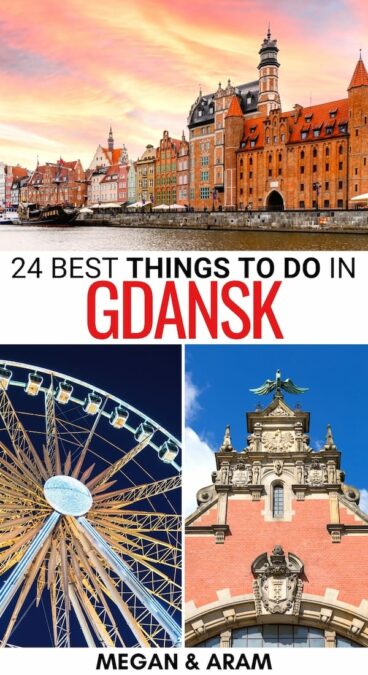
I knew you’d have something on Gdańsk! 🤗🤗🤗 thanks for the awesome coffee tips – that’s my morning coffee sorted now!
im just now seeing this aghhh! i hope you had a great trip <3